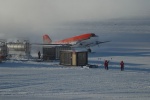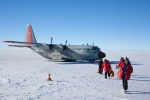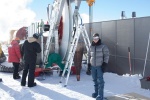There are
“winterovers”
467
Wednesday, December 5, 2012 - 1:30pm
There won’t be too many more shots of this South Pole marker. Each year, on the first of January, a ceremony is held in which a special new marker is placed at the spot of the current geographic South Pole.
Article
Wednesday, November 21, 2012 - 1:30pm
A nice halo sets a peaceful scene from the Pole, but it has been anything but quiet around there these days. Planes landing and taking off. Summer people arriving, winter people leaving. Hugs and photos.
Article
Monday, November 12, 2012 - 1:15pm
The time has come for the changing of the guard. Above, (L-R), Carlos Pobes, Felipe Pedreros Bustos, Blaise Kuo Tiong, and Sven Lidstrom pose in the South Pole "departure lounge."
Article
Friday, November 9, 2012 - 1:15pm
With the first planes of the summer season come an influx of new faces and fresh products for the South Pole station.
Article
Thursday, November 1, 2012 - 12:15pm
This week saw the first planes arriving for the summer season at the Pole—that’s pretty thrilling when you’ve been basically isolated for eight months.
Article
Friday, October 26, 2012 - 12:15pm
The winterovers report a rather uneventful week at the Pole. Nonetheless, beautiful pictures abound.
Article
Wednesday, July 18, 2012 - 2:00pm
The US flag flaps in the wind, as it undoubtedly did in many places across the US on July 4th, only at the South Pole it was lit by a bright moon with a lunar halo.
Article
Thursday, July 12, 2012 - 2:00pm
A quiet week at the Pole. Still, there’s always maintenance to be done, like status checks of the emergency fuel tanks (below, top) and a monthly fire alarm test at the IceCube Lab (below, bottom). Quiet, yes, but bright—perfect conditions for a walk.
Article
Wednesday, December 4, 2013 - 2:15pm
Open coat? No hat? It must be summer at the South Pole. Well, although it’s sunny outside it would probably be a stretch to call it warm, for those of us not used to it anyway.
Article
Monday, December 9, 2013 - 1:30pm
The drill in the center of this photo was designed for the Askaryan Radio Array (ARA), a neutrino detector much like the IceCube Neutrino Observatory. But while IceCube monitors the ice for flashes of radiation created in a neutrino interaction, ARA is designed to use radio waves to detect ultra-high-energy neutrinos.
Article










